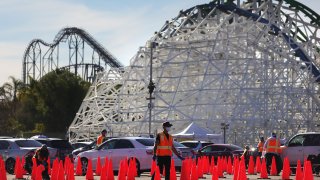
Six Flags Magic Mountain will reopen under California’s pandemic guidelines at the start of April after a nearly year-long closure due to the coronavirus.
The theme park in Valencia announced Thursday that it will reopen April 1 and 2 to members and pass holders before it welcomes back the general public on April 3. Capacity levels will be reduced to meet state guidelines and a new reservation system will be rolled out.
Tickets and reservations will be available online to California residents only.
Los Angeles County will continue to operate a COVID-19 vaccination site in the property’s parking lot.
Get top local stories in San Diego delivered to you every morning. Sign up for NBC San Diego's News Headlines newsletter.
Here are some of the health protocols.
- Distance markers for all ride lines.
- Handrails, ride units, and restraints will be sanitized throughout the day.
- Riders will be distanced to meet state guidelines and masks must be worn in the park.
- Guests and employees will be screened for temperatures before entering the park.
State health officials announced earlier this month that theme parks can reopen beginning April 1 in counties that have reached the red tier of the state's four-level Blueprint for a Safer Economy. Los Angeles County moved into the red tier last week after months in the most restrictive category.
The move followed several important milestones, with California ramping up vaccinations for the poorest neighborhoods, counties reopening more businesses and Gov. Gavin Newsom passing a measure aimed at encouraging schools that have restricted students to online learning to reopen classrooms this month.
U.S. & World
Only 11 counties remain in the most restrictive tier.
Theme parks in the red tier will be limited to 15% capacity.
California COVID-19 Vaccinations
The map tracks the number of doses administered by a recipient's county of residence according to the The California Department of Public Health.
Source: The statewide totals for doses administered reflect Centers for Disease Control and Prevention data. Otherwise we used data from the California Department of Public Health.
Amy O’Kruk/NBC



